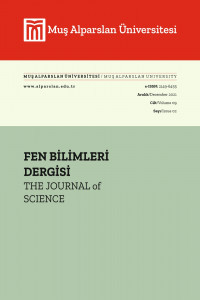Sıcak Presleme Yöntemiyle Üretilmiş B4C Takviyeli AA 7xxx Matrisli Fonksiyonel Derecelendirilmiş Malzemelerin Çapraz Kırılma Dayanımının Belirlenmesi
Bu çalışmada sıcak presleme yöntemiyle AA 7075 Al alaşımı tozları ve B4C parçacıkları ile fonksiyonel derecelendirilmiş malzemeler üretilmiştir. AA 7075 matris içerisine ağırlıkça %10 - %60 arasında değişen oranlarda B4C ilave edilmiştir. Matris malzeme ve parçacıklar 3 boyutlu karıştırıcıda karıştırılmıştır. Karışım tozlar değişen sıcaklık (250, 350 ve 450oC) ve basınç (200, 300 ve 400) değerlerinde preslenmiştir. Presleme işlemi sonrası 5 farklı geçiş bölgesine sahip fonksiyonel derecelendirilmiş malzemeler üretilmiştir. Geçiş bölgelerinin sertlik değişimini tespit için makro sertlik ölçümleri yapılmıştır. Üretilen numuneler tel erozyon yöntemi ile kesilerek standart boyutlarda çapraz kırılma test numuneleri elde edilmiştir. En yüksek çapraz kırılma dayanımına 450oC sıcaklıkta preslenen numunelerde ulaşılmıştır.
Anahtar Kelimeler:
Al7075, B4C, Çapraz kırma dayanımı, FDM
Investigation of Transverse Rupture Strength of AA7xxx Matrix Functional Graded Materials Reinforced B4C
In this work, functional graded materials were produced by hot pressing with AA7075 alloy powders and B4C particles. B4C particles between 10% and 60% by weight were added to the AA 7075 matrix. Matrix materials and particles were mixed in a three dimensional mixer. The blend powders were pressed at varying temperatures (250, 350 and 450°C) and pressures (200, 300 and 400 MPa). Functionally graded materials with 5 different transition zones were produced after pressing. Macro hardness measurements were made to determine the hardness change of the transition zones. The produced specimens were cut using wire electrical discharge machining (WEDM) and transverse rupture strength test specimens were obtained in standard sizes. The maximum transverse rupture strength was reached at 450oC samples.
Keywords:
Al7075, B4C, Cross-crushing strength, FDM,
___
- [1] Neubrand A., Neubrand J. Gradient materials: an overview of a novel concept, Zeitschrift fur Metallkunde, 88, 358-371, 1997.
- [2] Zygmuntowicz J., Miazga A., Konopka K., Kaszuwara W., Metal Particles Size Influence On Graded Structure In Composite Al2O3-Ni, Materials and Technology, 50, 537- 541, 2016.
- [3] Zhang X., Zhang H. Optimal design of functionally graded foam material under impact loading, International Journal of Mechanical Sciences, 68, 199-211, 2013.
- [4] Mahamood R. M., Akinlabi E. T., Shukla M., Pityana S. Functionally Graded Material: An Overview, 3, 1593-1597, 2012.
- [5] Taheri A. H., Hassani B., Moghaddam N. Z. Thermo-elastic optimization of material distribution of functionally graded structures by an isogeometrical approach, International Journal of Solids and Structures, 51, 416-429, 2014.
- [6] Mehboob H., Chang S. H. Evaluation of the development of tissue phenotypes: Bone fracture healing using functionally graded material composite bone plates, Composite Structures, 117, 105-113, 2014.
- [7] Zhu J., Lai Z., Yin Z., Jeon J., Lee S. Fabrication of ZrO2-NiCr functionally graded material by powder metallurgy, Materials Chemistry and Physics, 68, 130-135, 2001.
- [8] Nemat-Alla M. M., Ata M. H., Bayoumi M. R., Khair-Eldeen W. Powder metallurgical fabrication and microstructural investigations of Aluminium/Steel functionally graded material, Materials Sciences and Applications, 2, 1708-1718, 2011.
- ISSN: 2147-7930
- Yayın Aralığı: Yılda 2 Sayı
- Başlangıç: 2013
- Yayıncı: Muş Alparslan Üniversitesi
Sayıdaki Diğer Makaleler
Selçuk ÇEKER, Furkan ORHAN, Medine GÜLLÜCE, Güleray AĞAR
Bağlayıcı Tipinin Kaplanmış Kağıtların Fiziksel Özelliklerine Etkisi
Arif ÖZCAN, Ömer Bünyamin ZELZELE
Arduino Devreleri için Kod Üretme ve Veri İşleme Uygulaması Tasarımı
Volkan ÇAVUŞ, Resul TUNA, İsmail Umut DURAN
A new mathematical approximation for the current density of ionospheric plasma
Hanifi ÇİNİCİ, Uğur GÖKMEN, Görkem KIRMIZI, Ruziye ÇAMKERTEN
Lyapunov Üstelleri İle İris Örüntüsünün Kaotik Yapısının İncelenmesi
